The A-Team

The goal of any good military operation is reconstruction, helping a nation rebuild with the help of our armed forces. From Iraq and Afghanistan to Kosovo and Kuwait, the United States has been helping countries rebuild their nations with the use of stalwart and hardworking construction equipment, engineering everything from military bases to city infrastructure, while keeping contractors, soldiers and allies around the world safe and productive.
A number of the manufacturers we cover every month in the pages of Compact Equipment help engineer and manufacture military-grade equipment for America’s armed forces. Navistar, Case, JCB, Kubota, Doosan and many other equipment patriots build skid steers, track loaders, trucks, backhoes, generators and light towers for reconstruction efforts in battleground situations. These machines must traverse treacherous landscapes (mountains and desert environments like Afghanistan and Iraq), armored for combat, gunfire, chemical weapons and IEDs, digging, carrying and generating power in order to help rebuild a struggling nation.
In this special July 4th issue of CE, we honor this equipment, used by our military to help our troops and allies succeed, and we honor the men and women behind the wheels and joysticks of these machines who risk their lives to help raise up people around the world. Over the next eight pages, we’ve compiled the ultimate A-Team of American military construction equipment. Memorize their codenames, read their profiles and understand their skills and applications, so you can bring the mission of rebuilding community and culture back to your contracting business right here at home.
Keith Gribbins is managing editor of Compact Equipment, based in Peninsula, Ohio.
Codename: Cross Country
Real Name: International MaxxPro Dash Mine Resistant Ambush Protected
Alias: The MRAP
Mission: The International MaxxPro Mine Resistant Ambush Protected (MRAP) vehicle provides troops with an increased level of protection against ballistic arms fire, mine blasts, IEDs and nuclear, biological and chemical environments threatening the safety of its crew. Armoring flexibility allows upgrades to achieve a mission’s appropriate level of protection. Several size variants allow customization and upgrades to achieve the correct level of protection, based on mission requirements.
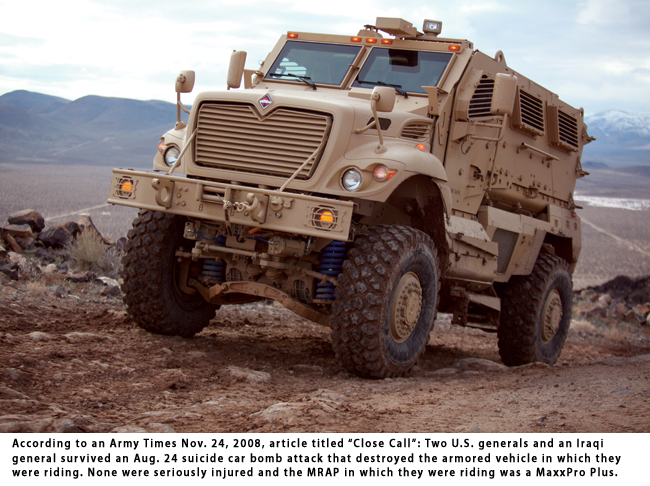
Skills: The enhanced MaxxPro Dash uses a number of armaments to protect troops. When it comes to ballistic protection, units are engineered with armor and glass protection to meet mission needs. For mine protection, the units’ specialized “V” shaped hull design protects against mine and IED blasts. The MaxxPro is also designed to accept additional add-on armor as mission requirements warrant. International is also selling and retrofitting units with a DXM suspension, which offers vehicle operators a turning circle of 54 ft, approximately 14.5 in. of wheel travel, as well as a number of enhanced capabilities. Upgrades have been made to the windows and doors, which continue to use an air-hydraulic system to ensure doors function in the most extreme situations.
Location: Navistar has established dealers in both Iraq and Afghanistan to support rebuilding efforts. In total, the company’s dealers and service parts suppliers in Iraq, Afghanistan, Kuwait, Saudi Arabia, UAE and Turkey have more than $6 million (USD) in parts inventory.
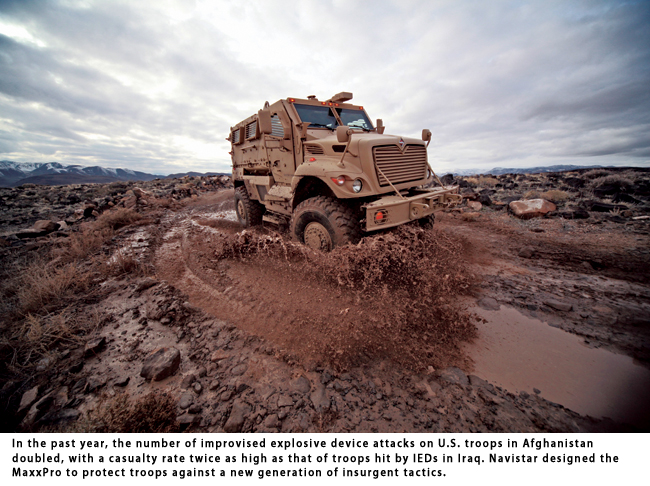
Endorsement: Regis Luther, vice president of military products and initiatives at Navistar Defense.
“In today’s changing combat environments, Navistar needs to do more than just provide a great MRAP,” Luther said. “Engineering teams need to anticipate evolving insurgent threats to keep vehicle designs relevant and ahead of the need. For example, the first and quickest way to get the DXM suspension into theater is to manufacture new vehicles with this capability already installed and in February we received a contract to do just that. By the end of summer 2010, we will have manufactured and delivered 1,050 MaxxPro Dash vehicles with the DXM suspension.”
Codename: Heavy-Metal
Real Name: The JCB High Mobility Engineer Excavator
Alias: HMEE (Pronounced “Hemmie”)
Mission: JCB’s HMEE is purpose-built for the U.S. Army
where it will provide battlefield commanders with a myriad of logistics
capabilities in front patrols. The HMEE incorporates three
characteristics essential for military success: mobility — able to
traverse rough terrain, the HMEE can create roads for military passage
under almost any conditions; counter-mobility — the strong, nimble HMEE
is a whiz at creating obstacles to foil the enemy; and survival — By
providing water and supplies, building berms and laying electrical
lines, the HMEE is an invaluable asset to soldiers in the field.
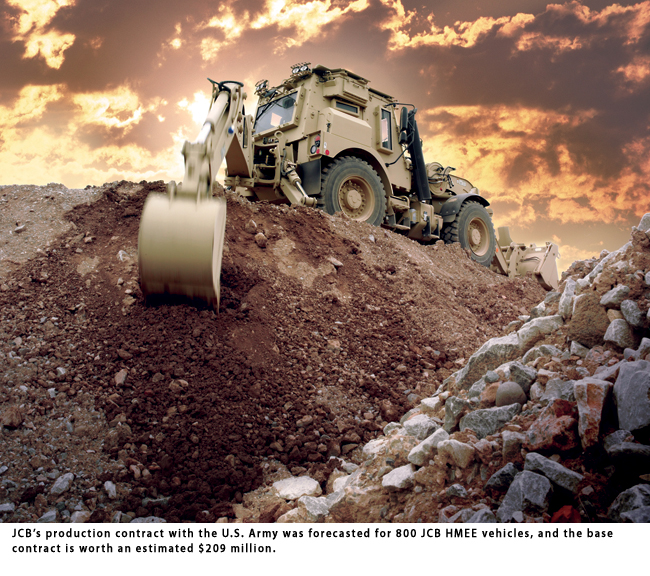
Skills: The JCB HMEE is the world’s fastest backhoe loader, traveling at speeds up to 60 mph on both paved road and cross-country surfaces. Weighing approximately 17.55 tons with armor and 15.75 tons without armor, the four-wheel drive, four-wheel steer machine with a 6.7-liter diesel engine can lift more than 2.2 tons and dig a depth of almost 13 ft. The JCB HMEE is the result of a four-year program of design, development and testing and was built specifically for the U.S. military as a replacement for their Small Emplacement Excavator (SEE). The majority of the JCB team producing the HMEE has served in the military, uniquely qualifying them to produce and maintain this exceptional vehicle for the end customer — the soldier in the field.
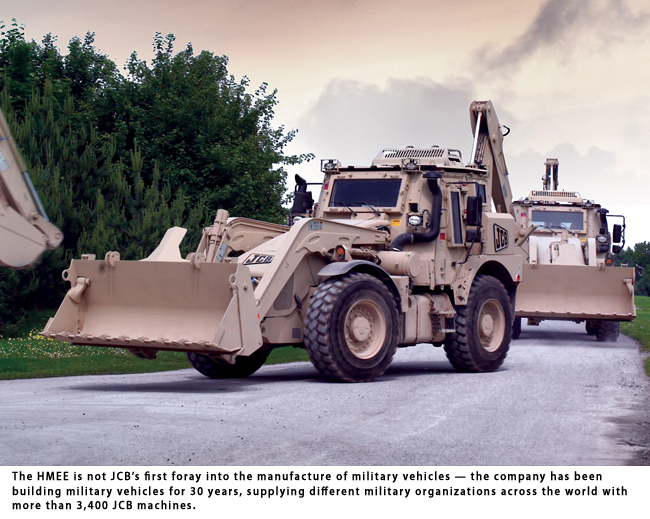
Specialties: Superior Protection: The JCB HMEE comes complete with sophisticated computer diagnostics, roll-over protection, full suspension and ABS braking technology, allowing for controlled stopping in difficult conditions. Run-flat tires reduce troop exposure and give operators time to reach safety.
Excellent Ride: The two-man, air-conditioned cab provides a comfortable, protective environment for soldiers. The excavator features JCB’s heavy-duty, steer-drive axles in the front and rear. Both axles incorporate JCB’s soft-engaged differentials, enabling on-the-move engagement of different locks.
Outstanding Mobility: Designed with operational mobility in mind, the HMEE comes with three operator steering modes available: two-wheel steer for on-highway travel; four-wheel steer for loading duties and confined sites; and crab steer for parallel drive when digging close to walls, on side slopes or other obstacles.
Location: Built at JCB’s North American Headquarters in Savannah, Ga., HMEEs are then deployed to Iraq and Afghanistan to complete their missions.
Commendations: A JCB HMEE was actually credited with saving a soldier’s life when an anti-tank mine exploded in Iraq in late May 2009. Staff Sgt. Adam Smith Jr., of the Germany-based 9th Engineer Battalion, 172nd Infantry Brigade, was digging a culvert trench near South Balad Ruz when an anti-tank mine exploded. It immobilized the armor-plated backhoe, but Smith walked away from the wreckage. “I’m thankful I was in the HMEE and not the SEE,” Smith said. Smith’s unit deployed to Iraq in January 2009 and had been working with other units in a variety of humanitarian functions, including clearing routes for and restoring infrastructure for the Iraqi people. “I am extremely happy with the blast protection offered by the HMEE. It saved my soldier’s life,” said Capt. Andrew Maxa, Company B, 9th Engineer Battalion commander.
Codename: Clutch
Real Name: The JLG All Terrain Lifter Army System II
Alias: ATLAS II
Mission: The ATLAS II is a highly maneuverable, rugged
material handler and is engineered for a variety of demanding military
applications such as combat operations, logistics support and ammunition
and supplies handling.
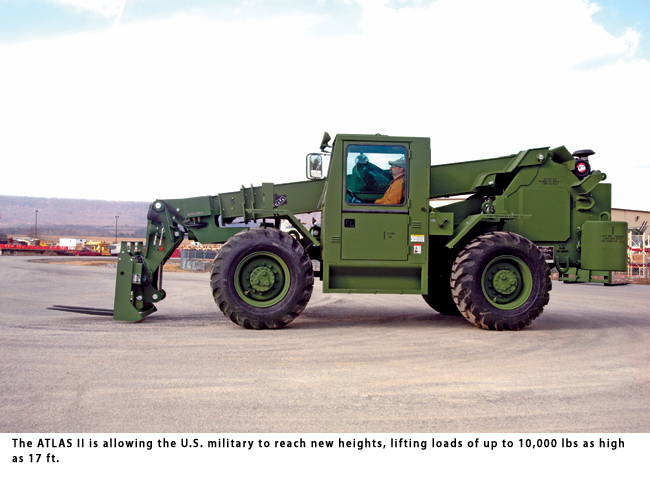
Skills: This unit was built to provide the military with superior reach, tremendous material handling versatility and the ability to handle rough terrain. The newest in the JLG line of military telehandlers, the ATLAS II is designed with more versatility and improved load-handling capabilities. With superior reach, the ATLAS II is built to reach into trucks or shipping containers, lift loads over obstacles and pick up loads from both above and below grade. Loads of up to 10,000 lbs can be lifted as high as 17 ft. With its four-wheel drive, high ground clearance, frame leveling and plenty of horsepower, the ATLAS II is made to go through uneven, rugged terrain, including snow, mud, sand and water.
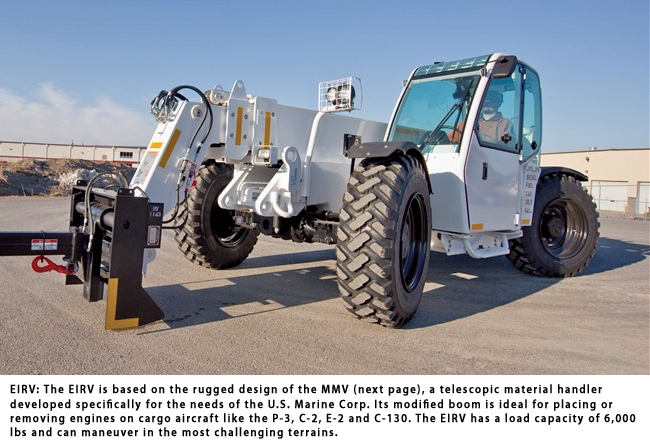
Specialties: Superior Reach: Unlike traditional lift trucks, JLG military telescopic handlers can reach into trucks and/or shipping containers, lift loads over trenches or other obstacles and pick up loads from above
or below grade.
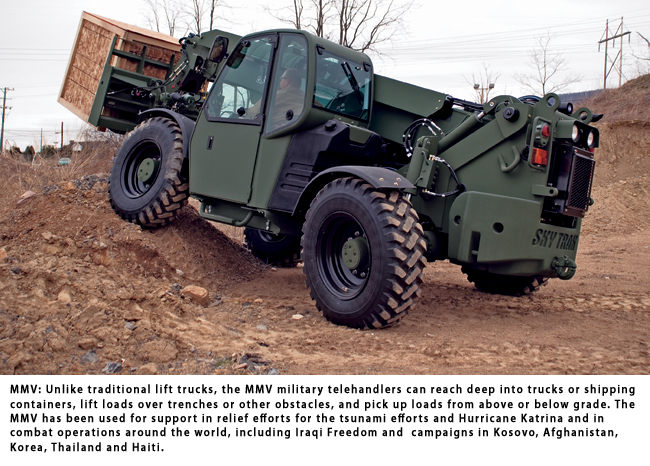
Material Handling Versatility: You can gain a unique advantage with JLG military telescopic handlers. Transport palletized materials easily. Lift and place materials weighing 10,000 lbs to heights of nearly 17 ft. JLG was chosen as a prime manufacturer of telescopic handler configurations for the U.S. Army for a reason.
Home Base: The ATLAS II is manufactured at JLG facilities in McConnellsburg, Pa.
Codename: The Taskmasters
Real Name: M400W Skid Steers and M400T Compact Track Loaders
Alias: Series 3 Case 420 and 420CT
Mission: Case Construction Equipment, Racine, Wis., began manufacturing the first of as many as 3,400 skid steer and compact track loaders under a 10-year, $160 million contract with the U.S. Army TACOM (Tank Automotive and Armaments Command). The contract, awarded in 2007, calls for as many as 1,900 M400W skid steers and 1,500 M400T compact track loaders, equivalent in basic specifications with the Case 420 and 420CT Series 3 models, respectively.
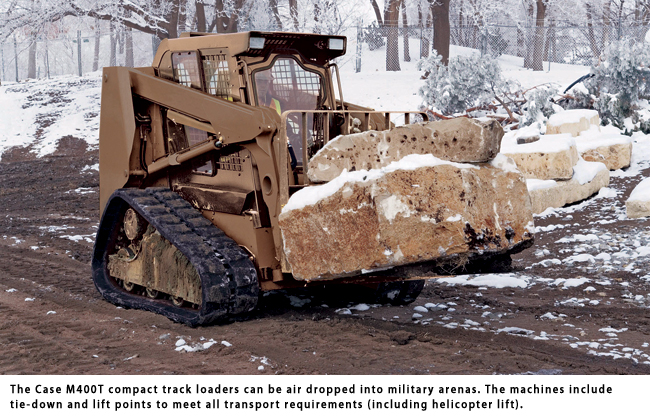
Skills: Military specifications for the machines include tie-down and lift points to meet all transport requirements (including helicopter lift). These military-grade loaders also include a host of extras, including: a weapons rack; 24-volt starting and charging system; a fuel-injection pump compatible with military-blend fuel; and a “NATO slave” electric cable receptacle. Each unit ships with a full complement of attachments, including an auger drive with two augers, a 4-in-1 multi-purpose bucket, pallet forks and a hydraulic hammer with multiple attachments. The attachments are housed in a specially designed container that allows rapid deployment of all the attachments.
Team Member Codename: Ground Breaker
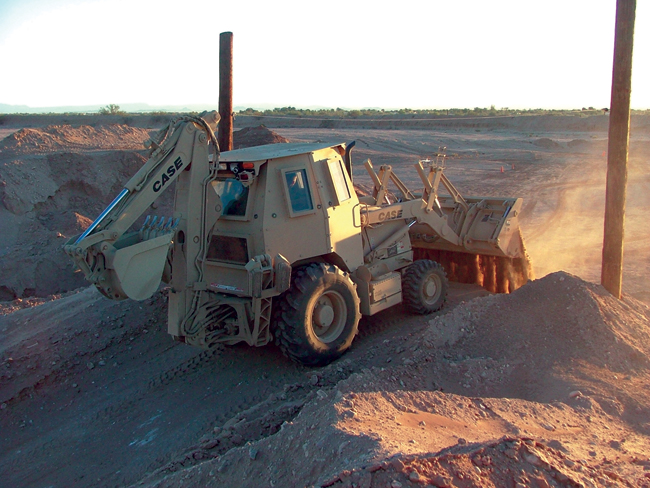
In 2008, Case began fielding armored and armor-ready backhoe loaders under a contract with the U.S. Army to build nearly 700 units. Fifty machines have been deployed to support the U.S. Army in Afghanistan and Iraq; 650 are or will be deployed in other locations worldwide. Armor panels for machine cabs are designed for quick interchange from armored to unarmored configuration. Four external cameras and three internal monitors provide ground-level view of work area, enhancing operability.
Codename: The Transporter
Real Name: Fontaine 635NL
Alias: Tank Retriever
Mission: Fontaine’s 635NL is built for the U.S.
Department of Defense, specifically to haul tanks and tracked armored
personnel carriers. Fontaine Trailer Co. (established 1940) is an
industry leader in the production of commercial platform type trailers.
Fontaine Trailer Military Products is the part of Fontaine Trailer Co.
totally focused on military trailers.
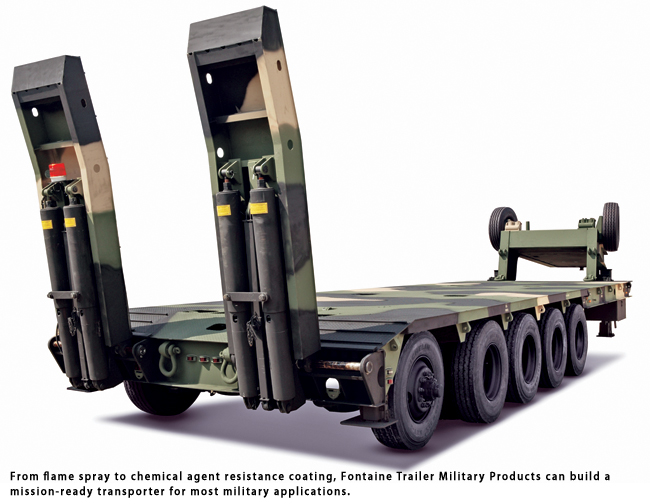
Skills: The Fontaine 635NL is a true workhorse that gets the job done the first time when it comes to heavy tow objectives. The 635NL can haul one M1A1, M1A2 or M60 tank or two M113 tracked armored personnel carriers.
Home Base: Built at Fontaine Trailer Military Products manufacturing facility in Jasper, Ala.
Team Members:
-
M871-A3: 22 1/2-ton break-bulk cargo hauler designed and built to help you “move the force.” Retractable ISO twist locks accommodate 20-ft intermodal containers.
-
M172A1: 25-ton lowbed equipment hauler trailer for on-road or off-load military needs.
-
AFLT 2540 Air Force Step Trailer: Designed for use on Air Force bases for general cargo and freight. It’s available in 25- or 40-ft lengths, it’s mainly used for off-dock loading and it’s designed to be shipped via air.
Commendations: The Fontaine Reset to Rebuild Standards Program
The Fontaine M871 and M872 Reset Program incorporates advanced trailer technologies to transform battle-weary trailers into mission-ready assets. Every trailer is 100 percent disassembled, stripped to bare metal, grit blasted and rebuilt to factory specifications to maintain the exact mission capabilities Components are replaced using the latest trailer technology so the final result is superior to the original new trailer. Spare parts are readily available from Fontaine PartSource at www.fontainemilitary.com.
Codename: Extinguisher
Real Name: Fire-Rescue Rough Terrain Vehicle
Alias: The Assault Force 70
Mission: The Fire-Rescue Rough Terrain Vehicles (FRRTV) are deployed to provide fire protection for the increasing population of U.S. bases around the world. The UTVs are manufactured by Kubota and then an aftermarket manufacturer called EJ Metals, a Wisconsin-based upfitter of wild land fire trucks, reconfigures the units, dubbing each mini fire truck as the Assault Force 70.
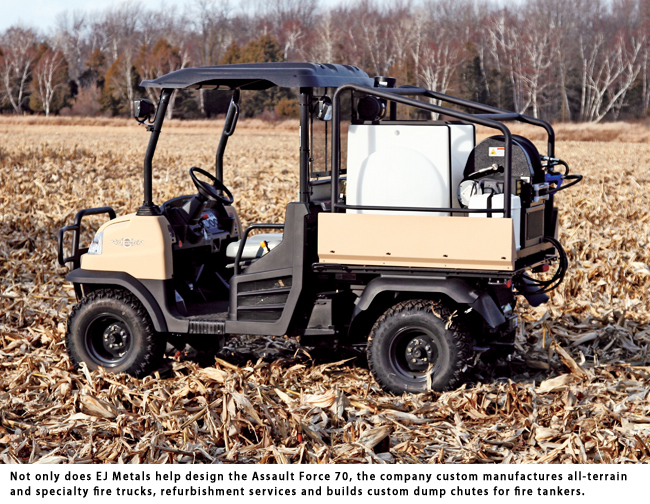
Skills: The Assault Force 70 is a unique, off-road fire fighting model that provides the best fire fighting capability of any rough terrain vehicle in the industry. It features a 70-gal water tank, a 5-gal Class A foam cell, a high-pressure fire pump and a patented, triple-discharge nozzle that allows firefighters to attack brush, wild land, vehicle and structural fires with a variety of water/foam streams. The hydraulically driven, high-pressure system provides 6 gallons-per-minute (gpm) of water/foam discharge at 1,500 psi, delivering approximately 12 minutes of discharge time.
Location: The Fire-Rescue Rough Terrain Vehicles will be deployed to Forward Operating Base Shank, Afghanistan, to provide fire protection for the increasing population of U.S. war fighters in the region.
Endorsement: Kevin Quinn, president of EJ Metals.
“We’re so proud that our newest fire fighting vehicle, the Assault Force 70, will be providing fire protection to the men and women protecting freedom in Afghanistan,” said Quinn. “This FRRTV features the latest high-pressure fire fighting technology to provide the ultimate in fire protection for U.S. military installations. It simply lets the U.S. Army do more fire fighting with less water and foam, at a very affordable price, and it provides remarkable versatility and goes nearly anywhere. Our team members couldn’t be prouder to support our military forces this way. The FRRTV is extremely versatile and easy to use. It’s so simple to operate that it can be put into action quickly and effectively with minimal operator training, allowing these Assault Force 70s to begin providing fire protection on base immediately.”


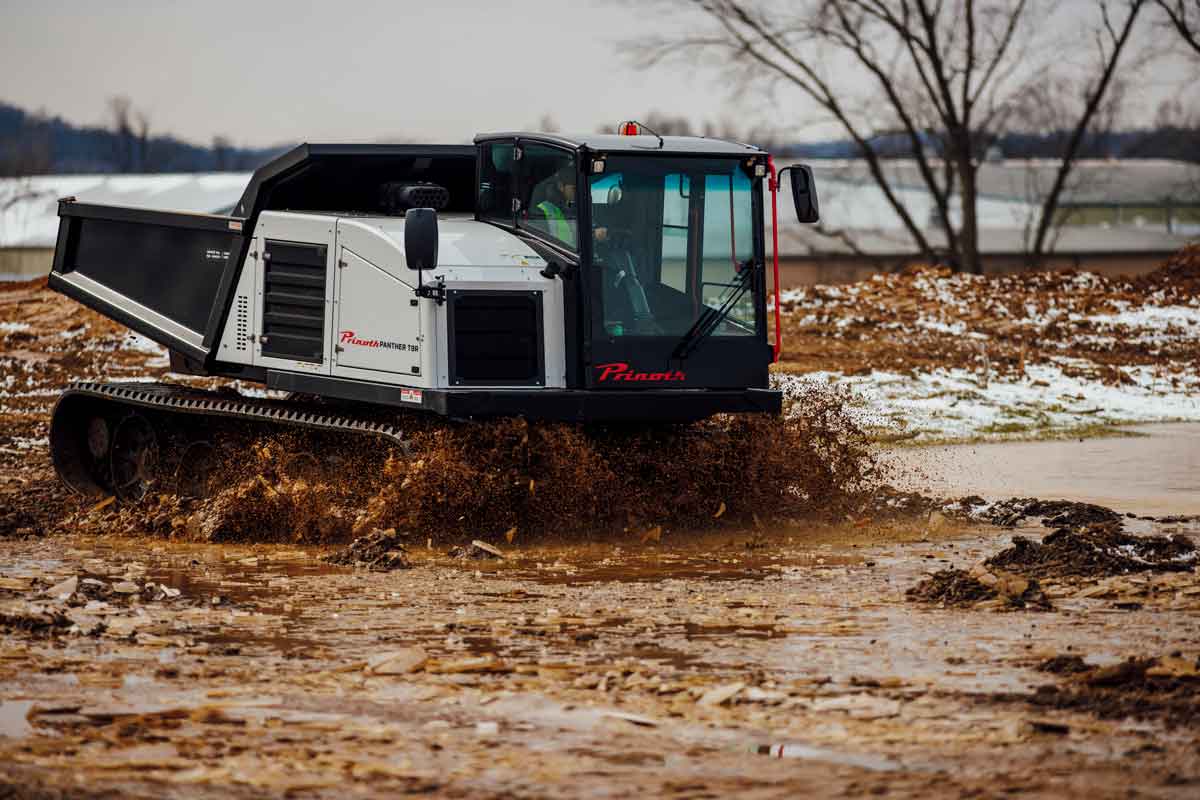


Comments are closed here.